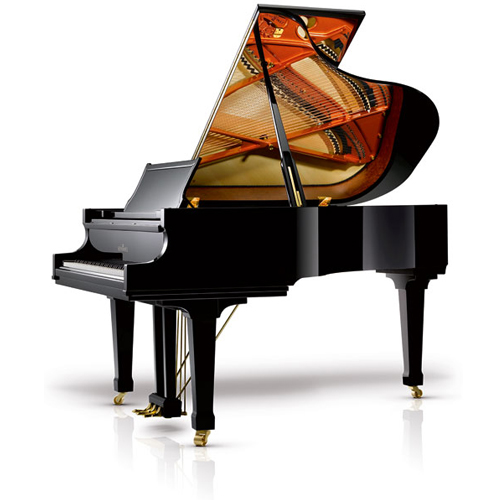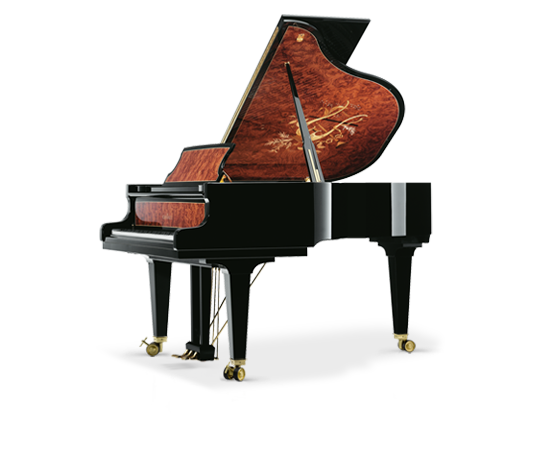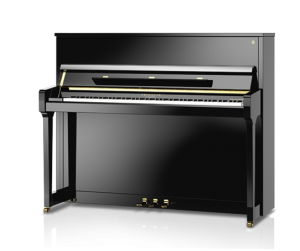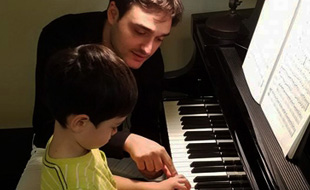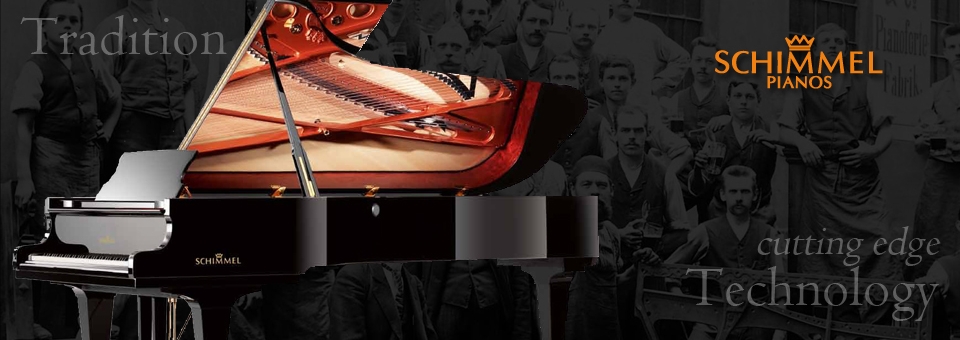
Each note a concert experience
Four generations – One passion
Since 1885, it has been Schimmel’s passion to employ artistic craftsmanship, and knowledge to enable uncounted people, famous, well-known and unknown, to achieve their keys to happiness.
Success demands courage – and passion. Both of these qualities were demonstrated by Willhelm Schimmel, the founder of the company. Shortly after the completion of his training as a piano manufacturer, he established his own workshop in Leipzig and produced his first piano at the beginning of 1885. His instruments were impressive for their advanced technique, excellent tone and contemporary form. Both he and his slogan, “Quality will prevail,” were proved right by his success. In 1927, his son Wilhelm Arno Schimmel took over the management of the company and relocated the site to Braunschweig (Brunswick), where he developed one of the major innovations of the 1930s: a small piano without back posts, with a newly designed action and a unique tonal character. The family firm continued to flourish: by the end of the 1950s, Schimmel instruments were the most frequently purchased pianos in Germany – and were being sent all around the world.
The masters of a good tone
The piano craftsmen at Schimmel employ their entire range of experience and commitment to enable pianos and grand pianos to develop their natural tonal volume, allow great compositions to be performed with appropriate tonal strength and permit pianists to display their virtuosity. Both upright and grand pianos are extremely sensitive instruments. To achieve a consummate tone, specialists are required with instincts who have a feel for the most minute tonal nuances, and also possess a high degree of patience.
The quality of each individual instrument is dependent on this specialized craftsmanship. For example, the voicing of the instrumental timbre is formed by extensive needling – several hundred times per hammer-head – a total of 88 per instrument. This specialized task requires a highly sensitive and well-trained ear, which cannot be substituted by an electronic instrument. The same applies to the over 10,000 individual elements of each instrument which must all be meticulously synchronized with exact precision: from the fitting of the strings, the positioning of the hammer-heads and the regulation of the action, to the fine art of tuning and voicing. Additional necessary attributes include comprehensive knowledge and skills relating to the casing, a love of the natural produce wood and the artistic design of individual inlay work.
Experience in these areas has been cultivated, preserved and passed on for several generations in the firm. Some of Schimmel’s manufacturing specialists currently employed have fathers – or in some cases even grandfathers – who were also employed within the same profession. It takes three and a half years to complete the training as a specialist piano manufacturer, and a further nine and a half years are necessary to achieve the title of master; Schimmel is one of few the manufacturing firms to offer this opportunity. Craftsmanship at Schimmel represents a capital investment which has grown over more than a century and is fostered new every day!
The stuff of which music is created
Some might consider it a quirk to utilize up to 300 year-old mountain spruce from premium mountainous areas for Schimmel soundboards: Schimmel’s masters call it quality. It could equally be asked whether is it absolutely necessary for the hammer-head felts to be manufactured from the wool of specially reared merino sheep? Yes, without doubt, as it is top-class materials which provide the prerequisites for a first-class sound. This concept is not mere indulgence in luxury, but a solid basis for the construction of premium quality instruments.
This fundamental concept runs throughout all aspects of piano manufacture at Schimmel. A prime example is the cast-iron frame, which undertakes the Herculean task of withstanding the enormous tension of over 200 resonating strings with a tension of 80 to 130 kilograms per string, amounting to a total of 21 tons. For this reason, cast-iron technology and metal alloys must be perfect, as each gram has its own purpose. Identical standards also apply to the piano varnish, which is applied in a total of 13 work steps and subsequently given a high gloss finish. All of this is necessary to permit the full character of a Schimmel instrument to develop.
This is one of the reasons why Schimmel attaches such great importance to the careful selection of expert processing of wood. This affects not only the aesthetics, but also the tone and durability of the instruments – and these do not tolerate any compromises. Schimmel’s fine woods are dried slowly and carefully, preserving the appropriate moisture content to enable them to retain their lasting value.
Time is a further valuable element which we employ for the benefit of our instruments, such as for the acoustic elements of the instruments which are periodically left to rest between the individual work phases. This allows the materials to become acquainted with the enormous tension ratios of the instruments in order to develop a stable equilibrium. Faultless materials and their careful and expert processing are essential for the production of top-quality instruments and great enjoyment in playing for lifelong pleasure!
The foundations of excellent tonal qualities
This has less to do with mysticism in piano manufacturing than with hard work and persistence. An example is the cast-iron instrument frame which has to withstand up to 21 tons of tension weight. At the same time, this frame has to be constructed with the minimum employment of materials as this can otherwise absorb valuable oscillation energy. Schimmel discovered the solution with the aid of state-of-the-art computer technology which allowed them to simulate forces and subsequently construct cast-iron plates with an ideal material distribution.
The secrets of a good tone are contained in the details. For this reason, Schimmel undertakes fundamental research, for example into oscillation qualities of wood and resonance strings. Schimmel experts work in cooperation with renowned scientists and institutes. This unique CAPE software (Computer Assisted Piano Engineering) was developed over the years at Schimmel on the basis of this concentrated know-how and aids Schimmel piano experts in the development of new models. In addition, this creates new possibilities which had not been available in the past. An example is the new development of the worldwide unique concept of the Schimmel Trilogy. The great ingenuity and inventiveness of Schimmel piano experts is one of the best sources for the enjoyment of music!
The unique Schimmel Trilogy
Some designers copy construction concepts from nature. Schimmel has, in a matter of speaking, copied themselves, transferring their grand piano know-how to a smaller format. In the unique Schimmel Trilogy Concept, the well-established and ideal construction concepts for the large grand piano series have been consistently integrated into the smaller models series – where possible in identical construction. This enabled pianists to enjoy the benefits of the outstanding touch and tonal characteristics of a large concert grand even when performing on small models.
Enlarged soundboard
Greater volume of sound compared with a standard grand piano of similar size. On average the soundboard area is 15 percent larger than a standard grand piano.
The ideal soundboard wood – exclusive to Schimmel
Only spruce grown under specific climate circumstances in high mountain regions can be used to make a high quality soundboard. This wood, which is rare and of high value, is exclusively selected and reserved for Schimmel by the Bavarian forestry service.
Schimmel Sound production system
Uniform harmonic sound spectrum in all registers, the greater richness and sensitive control of the sound are all enabled by the tapered soundboard and stressed sound producing portion of the Schimmel piano – known as the Schimmel Sound system.
Triplex Scale
Harmonic richness of tone is achieved through the integration of the front and rear sections of the string into the production of the sound. The tunable triplex scale allows precise voicing of the partials (harmonics) for every individual note.
Full size concert grand piano scale
Through the use of the same scaling as the full concert grand piano – there is always an element of the large instrument’s sound in the smaller Schimmel grands.
Mass reduced bridge
Schimmel concert bridges possess a dynamic groove which makes these bridges lighter and the soundboard more flexible. This produces superior tonal dynamics and longer sustained notes.
Key tops made of mineral material and ebony wood
The keys offer an improved sensation of touch and are less slippery than modern keys due to the refinement of the key top material (similar to ivory).






